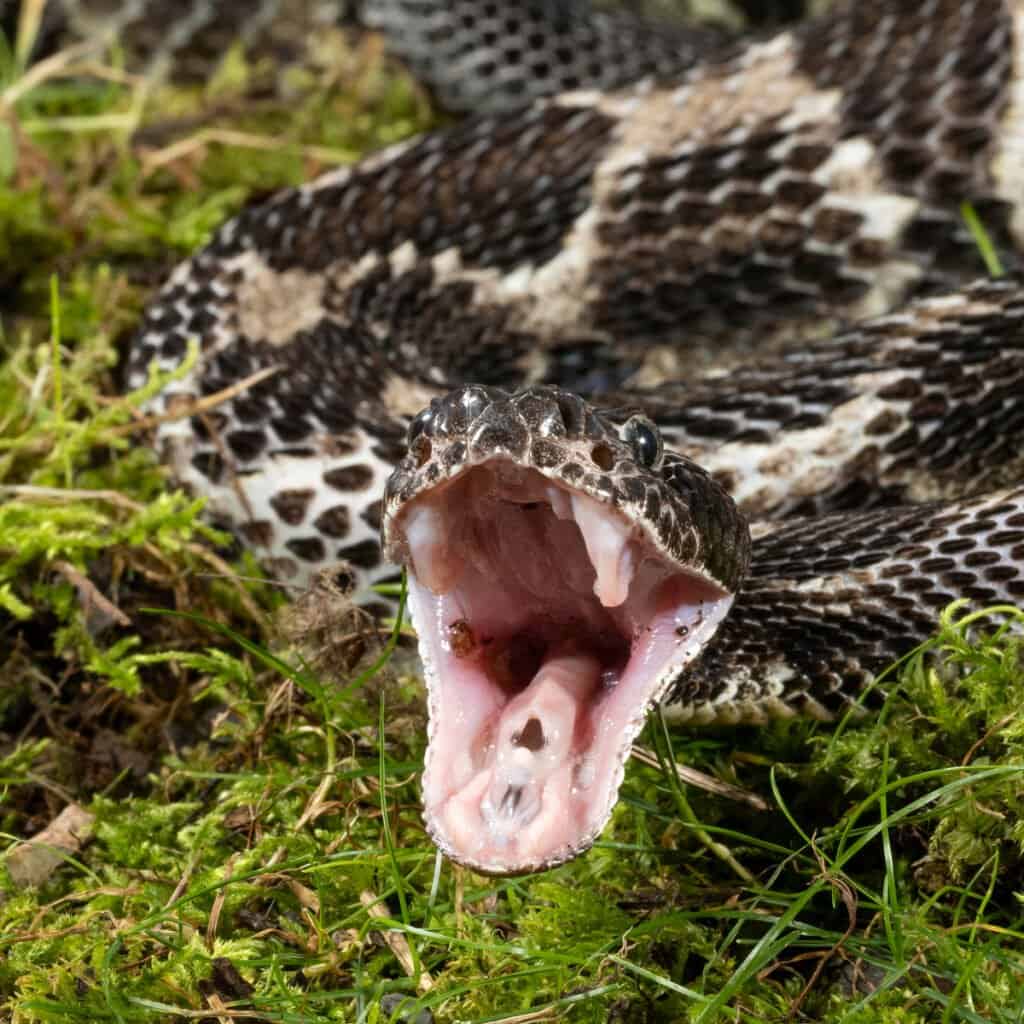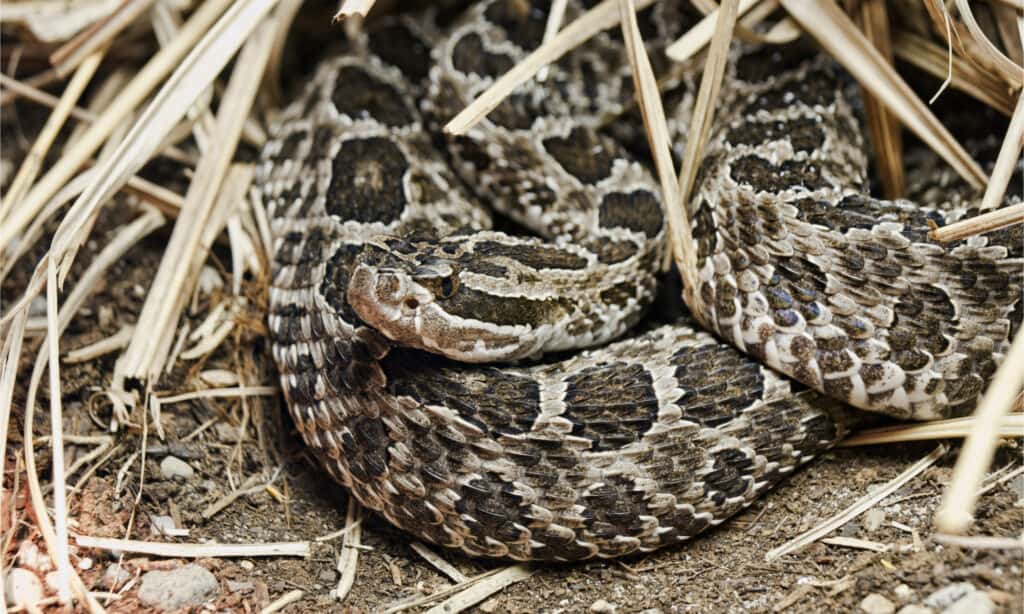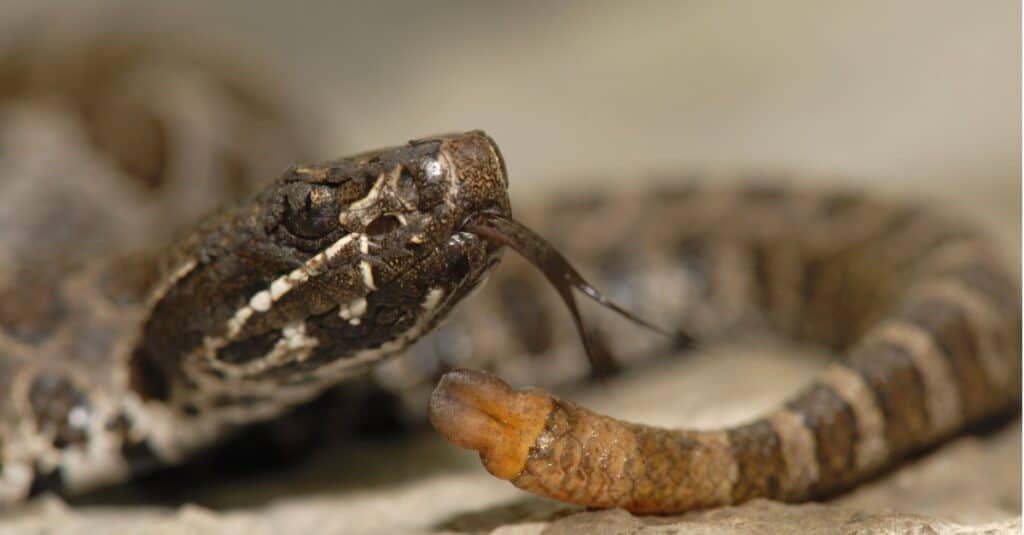Minnesota is the twelfth largest state in the US and is home to many fascinating animals – including snakes. There are 17 species of snakes in Minnesota and most of them are completely harmless. Snakes are venomous rather than poisonous as their venom is injected rather than ingested. In fact, there are only two venomous snakes in Minnesota. Luckily, they are only found in the southeastern parts of the state which means that there are not found across the vast majority of the region. So join us as we discover everything you need to know about venomous snakes in Minnesota!
Timber Rattlesnake

Timber rattlesnakes have thick, heavy bodies which make them look intimidating.
©Frode Jacobsen/Shutterstock.com
Also known as the canebrake rattlesnake, the timber rattlesnakes (Crotalus horridus) are large pit vipers which are between 36 and 60 inches long. Timber rattlesnakes have a heavy, thick-set body which is usually yellowish or greyish brown. They also have dark brown or black crossband markings. Their tail is black and ends with a rattle which is typically held up above the ground. Timber rattlesnakes prefer deciduous forests, damp fields, and swamps, but are occasionally found in urban areas. During the winter, they live in dens in a dormant state known as “brumation”. Dens are usually on a rocky cliff edge or on a slope where they have good protection from the cold. Quite often, dens are shared with other snakes – such as North American racers and milksnakes.
Timber rattlesnakes are viviparous and females give birth to between 1 and 20 live young (average 7) after a 135-day gestation period. The newborn snakes remain with their mother for around two weeks before they have to survive entirely on their own. Despite this, they actually have a low reproduction rate. Females don’t mature until they are around 7 years old and they only reproduce every 3 to 5 years. Although not widely threatened across the entire country, timber rattlesnakes have been classed as a threatened species in Minnesota since 1996, with the low rate of reproduction being one of the main factors.
Venom

Timber rattlesnakes have fangs that are 4 to 6 inches long.
©Joe McDonald/Shutterstock.com
Timber rattlesnakes are actually one of the most venomous snakes in North America as they contain a large amount of venom. They have incredibly long fangs with which to inject their venom. Their fangs are between 4 and 6 inches long and are a highly effective method of delivery. Despite being incredibly venomous, timber rattlesnakes are not particularly aggressive and generally prefer to flee rather than attack. Even when they do decide to strike, they tend to rattle their tail and feint a lot in an attempt to ward off the threat first.
Timber rattlesnakes are ambush predators and typically wait on fallen logs for the perfect moment to strike their prey from above. Their diet consists mainly of small mammals such as rodents, but they also eat birds and frogs. They eat other snakes and seem to prefer garter snakes to other species.
Eastern Massasauga

Eastern massasaugas look similar to timber rattlesnakes but are smaller.
©DnDavis/Shutterstock.com
Formerly a recognized subspecies of the massasauga snake, eastern massasaugas (Sistrurus catenatus catenatus) are now (tentatively) classified as a species on their own. They are medium-sized rattlesnakes at 18 to 30 inches long but significantly smaller than timber rattlesnakes. Eastern massasaugas are greyish brown with large brown blotches down the center of their backs and two to three rows of smaller spots down each side. They have a particularly unique rattle as it tends to sound more like a buzzing sound than a typical rattle. The sound of their rattle can usually only be heard within a range of around 5 feet.
They generally prefer wetland habitats such as swamps and marshes. However, they also occur in grasslands and woods during the summer months. Areas which include crayfish and small mammal burrows, tree stumps, and rocky crevices are particularly important for overwintering between mid-October and late April.
Eastern massasaugas give birth in the summer after a 2 to 4 months gestation period. They are ovoviviparous and give birth to fully formed live young, which hatch from eggs inside the female’s body. Clutch size ranges between 3 and 20 and the newborns are 7 to 10 inches long when they are born. They stay with the female for approximately one week before they become entirely independent.
Eastern massasaugas are an endangered species within Minnesota. They are incredibly shy and secretive snakes, and there are very few recent reliable sightings of them within the state. In fact, there is currently no evidence to suggest that there are even any breeding populations of these snakes within Minnesota.
Venom

Eastern massasaugas are highly venomous even though they are not particularly aggressive.
©iStock.com/Shoemcfly
Despite being highly venomous, eastern massasaugas are not particularly aggressive and rarely strike unless they are accidentally stepped on or are being handled. However, their venom is very dangerous as it is cytotoxic, which means that it destroys tissue. It also contains enzymes that prevent blood from clotting. Luckily, they have short fangs and cannot inject much venom in one go, but young children and the elderly are still particularly vulnerable.
Eastern massasaugas are ambush predators and prey mainly on small mammals and lizards. However, frogs are the main prey of juveniles. Due to the nature of their venom, eastern massasaugas are able to bite their prey and then hang back while the venom works. Most prey die from internal bleeding. Others can be partially broken down by the venom before the snake even consumes them.
The photo featured at the top of this post is © Joe McDonald/Shutterstock.com
Discover the "Monster" Snake 5X Bigger than an Anaconda
Every day A-Z Animals sends out some of the most incredible facts in the world from our free newsletter. Want to discover the 10 most beautiful snakes in the world, a "snake island" where you're never more than 3 feet from danger, or a "monster" snake 5X larger than an anaconda? Then sign up right now and you'll start receiving our daily newsletter absolutely free.
Thank you for reading! Have some feedback for us? Contact the AZ Animals editorial team.






